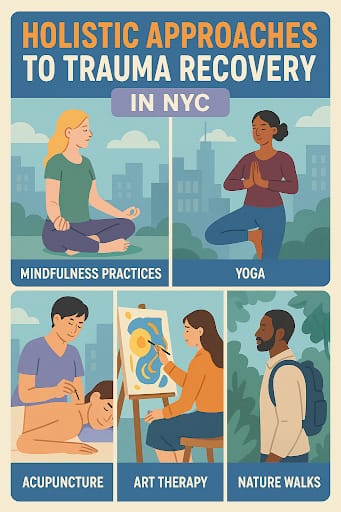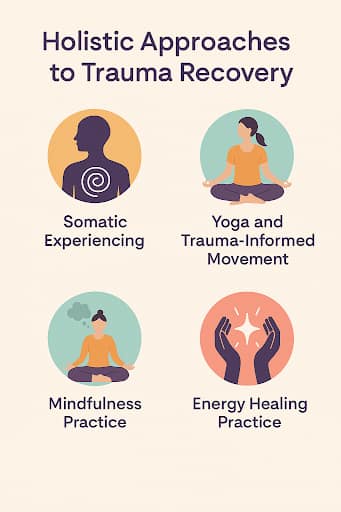
INTRODUCTION
Trauma impacts us not only mentally, but physically and spiritually as well. Traditional therapy is often powerful, but many people are looking for deeper healing, more integrated healing. Holistic trauma recovery emphasizes healing the whole person-not just treating symptoms- through holistic therapies that restore balance, build resilience and provide ongoing wellness.
When a survivor can receive psychotherapy with some alternative healing modalities, such as yoga, meditation, nutrition and energy healing, they will have the capacity to reconnect and feel a sense of safety and inner peace again. In this blog we will look at how a holistic approach to trauma recovery brings a compassionate and empowering experience to healing trauma.
Understanding Trauma and Its Effect
Trauma is the emotional and physiological response to extreme distress or life-threatening experience such as child abuse, domestic violence, natural disasters, war or serious accidents.
- Trauma overwhelms the nervous system and a sense of safety and a sense of stability is shattered.
- When responding to trauma, a person may experience a wide range of symptoms and these disorders vary greatly from individual to individual.
- Symptoms of trauma could be flashbacks, intrusive thoughts or memories, anxiety, panic attacks, emotional numbness and denial, insomnia and changes in a sleep cycle, hypervigilance, and physical symptoms such as chronic pain, persistent headaches, tiredness and fatigue.
- Trauma symptoms may even damage relationships and create distrust.
Trauma does not exist only in the mind; it has a physical component. It is important to understand trauma from an understanding that trauma lives in the body, and this fact forms the backbone of the holistic principles associated with trauma treatment.
What Is Holistic Trauma Recovery?
Holistic trauma recovery operates from a whole person perspective, meaning recovery work must include mind, body and spirit. Trauma is often drawn from the body, and therefore recovery work must incorporate the work needed to heal all aspects of a person’s being.
- The mind-body connection provides individuals with an opportunity to reconnect with their physical bodies while also seeing depression, trauma and anxiety presented in the body as fatigue, muscle tension, chronic illness, etc.
- Somatic therapies help release stored physical patterns in the body and to help restore flow of energy to and from the body.
- In addition, self-awareness and mindfulness are important to help individuals use awareness of triggers, and develop emotional regulation, and then become more present moment aware.
- We can support spiritual healing which doesn’t need to be religious, and invite individuals on journeys of purpose, meaning, connection, and deeper sense of self.
- Community is also important, as many holistic centers in NYC created a sense of community through groups, healing circles and workshops to cultivate shared experiences and connections that support collective healing.
Ultimately, holistic trauma recovery fosters the potential for individuals to become engaged participants in recovery work which supports building resilience and autonomy, and looking at recovery as sustainable long-term health and well-being.
Holistic Approaches to Trauma Recovery

1. Somatic Experiencing
Somatic Experiencing (SE), developed by Dr. Peter Levine, is a type of body-based therapy based on the premise that trauma lies within the nervous system.
- SE can be a gentle process which works by supporting a person to notice their internal sensations of tightness, vibration, warmth etc., and gradually process the sensations.
- The client can allow their body to complete the process (or natural completion) of the fight, flight or freeze that was interrupted during their traumatic event.
- SE works to release the energy that has been trapped post-trauma in order to rebalance your nervous system, to help reduce hyperarousal or dissociation, physical symptoms caused by trauma, and help you reconnect to your body and your inner resilience.
2. Yoga and Trauma-Informed Movement
Trauma-sensitive yoga is a supportive and gentle body-based practice for trauma survivors to reconnect safely with the physical body. It is different from traditional yoga, which may involve hands-on adjustments, and is very focused on choice, autonomy, and mindful awareness.
- The practice involves slow, intentional movements and postures and breath to create connectivity to stability and presence in the here and now.
- It also helps when you use language like, “sit in a comfortable position,” “lie down,” or “rest”.
- By creating a safe environment for the trauma-informed practice, survivors are encouraged to attempt to reconnect with movement in a shame-free zone.
- Trauma-informed and trauma-sensitive yoga are especially useful for those searching for body awareness, self-efficacy, help with emotional regulation, to release stuck muscular tension, and create a sense of safety and control.
- Trauma-sensitive yoga encourages the practitioner to reclaim agency and ownership over the body as part of the healing process and is a compassionate approach to healing.
3. Mindfulness Practice
Mindfulness meditation is a tool to help people recover from trauma and to explore (see) their thoughts, emotions and body sensations in a non-judgmental way.
- Mindfulness can help trauma survivors reduce the intensity of their triggers and cultivate emotional resilience when non-reactively observing their thoughts and sensations.
- Mindfulness techniques include body scans, breath awareness, loving kindness meditation (Metta), and grounding techniques, all strategies to keeping your attention on the present moment.
- Mindfulness practice decreases stress reactivity and anxiety and encourages emotional regulation in addition to fostering acceptance and self-compassion as they occur.
- Over time, mindfulness practice encourages trauma survivors to respond to traumatic memories, rather than reacting, facilitating a greater sense of peace and healing for the survivor.
4. Energy Healing Practice
Energy healing approaches address the subtle imbalances of trauma on the energy system of the body. Energy practices aim to release blockages in energy pathways and optimally return you to a position of natural flow of energy, and thus wholeness.
- Some modalities include Reiki- the Japanese practice where practitioners channel healing energy through their hands; acupuncture- stimulating meridian with fine needles to open the flow of energy; and therapy-style interventions like healing touch modalities, or chakra balancing.
- All these approaches encourage the experience of profound relaxation, physical and emotional pain relief, and the release of emotions.
- Practices restore energetic balance to help people feel more grounded, balanced, and connected as adults on their journeys of trauma healing.
The Importance of Safety and Professional Guidance
Holistic approaches are powerful processes to heal from trauma, yet it is important to acknowledge that recovery is a sensitive, complicated process. Recovery must always be based on safety.
- Professionals who work with an understanding of trauma-informed principles or philosophies are mainly helpful when in the course of recovery to ensure they can be supporting and non-judgmental or dismissive, and thus not re-traumatizing an individual.
- A survivor should never feel that they are being rushed or disrespected in their journey as they move through trauma recovery.
- Trauma recovery professionals should empower survivors by giving respect and consent to the survivors when making choices that may be difficult.
- Survivors should search for therapists or healers who have been trained in trauma recovery and can use evidence-based, body-aware learning, and can develop compassionate, safe spaces for healing and recovery.
Final Thought
Holistic trauma recovery in NYC provides a mindful, integrative route toward healing that recognizes the mind, body, and spirit.
- By combining psychotherapy with somatic experiencing, trauma-informed yoga, mindfulness, and energy work, survivors can learn to tend to their own minds and bodies while finding connection and resilience.
- These therapies facilitate long-term health and self-agency in addition to healing symptoms.
Trauma-informed professionals assist survivors in reclaiming their agency and healing on their own terms at their own pace, and the various holistic options available in a city like NYC allow trauma recovery to become a journey of reconnection.
Reference
- Treatment, C. F. S. A. (2014). Understanding the impact of trauma. Trauma-Informed Care in Behavioral Health Services – NCBI Bookshelf.
- Kuhfuß, M., Maldei, T., Hetmanek, A., & Baumann, N. (2021). Somatic experiencing – effectiveness and key factors of a body-oriented trauma therapy: A scoping literature review. European Journal of Psychotraumatology, 12(1), 1929023. https://doi.org/10.1080/20008198.2021.1929023
- West, J., Liang, B., & Spinazzola, J. (2016). Trauma Sensitive Yoga as a complementary treatment for posttraumatic stress disorder: A Qualitative Descriptive analysis. International Journal of Stress Management, 24(2), 173. https://doi.org/10.1037/str0000040
- Boyd, J. E., Lanius, R. A., & McKinnon, M. C. (2017). Mindfulness-based treatments for posttraumatic stress disorder: A review of the treatment literature and neurobiological evidence. Journal of Psychiatry & Neuroscience : JPN, 43(1), 7. https://doi.org/10.1503/jpn.170021
- Ding, N., Li, L., Song, K., Huang, A., & Zhang, H. (2020). Efficacy and safety of acupuncture in treating post-traumatic stress disorder: A protocol for systematic review and meta-analysis. Medicine, 99(26), e20700. https://doi.org/10.1097/MD.0000000000020700






